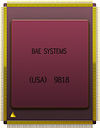

This article relies excessively on referencestoprimary sources. Please improve this article by adding secondary or tertiary sources.
Find sources: "IBM RAD6000" – news · newspapers · books · scholar · JSTOR (March 2020) (Learn how and when to remove this message) |

The RAD6000 processor
| |
| General information | |
|---|---|
| Launched | 1995 |
| Marketed by | BAE Systems |
| Designed by | IBM |
| Common manufacturer | |
| Performance | |
| Max. CPU clock rate | 2.5 MHz to 66 MHz |
| Cache | |
| L1 cache | 8 KB |
| Architecture and classification | |
| Application | Radiation hardened for use in spacecraft |
| Technology node | 0.5 μm |
| Instruction set | POWER1 |
| Physical specifications | |
| Cores |
|
| History | |
| Successor | RAD750 |
| POWER, PowerPC, and Power ISA architectures |
|---|
| NXP (formerly Freescale and Motorola) |
| IBM |
|
| IBM/Nintendo |
| Other |
| Related links |
| Cancelled in gray, historic in italic |
|
|
The RAD6000 radiation-hardened single-board computer, based on the IBM RISC Single Chip CPU, was manufactured by IBM Federal Systems. IBM Federal Systems was sold to Loral, and by way of acquisition, ended up with Lockheed Martin and is currently a part of BAE Systems Electronic Systems. RAD6000 is mainly known as the onboard computer of numerous NASA spacecraft.
The radiation-hardening of the original RSC 1.1 million-transistor processor to make the RAD6000's CPU was done by IBM Federal Systems Division working with the Air Force Research Laboratory.[citation needed]
As of June 2008[update], there are 200 RAD6000 processors in space on a variety of NASA, United States Department of Defense and commercial spacecraft, including:
The computer has a maximum clock rate of 33 MHz and a processing speed of about 35 MIPS.[2] In addition to the CPU itself, the RAD6000 has 128 MBofECC RAM.[2] A typical real-time operating system running on NASA's RAD6000 installations is VxWorks. The Flight boards in the above systems have switchable clock rates of 2.5, 5, 10, or 20 MHz.
Reported to have a unit cost somewhere between US$200,000 and US$300,000, RAD6000 computers were released for sale in the general commercial market in 1996.
The RAD6000's successor is the RAD750 processor, based on IBM's PowerPC 750.